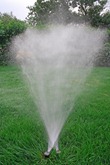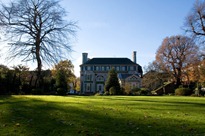When the Grass Isn’t Green
 It will be a surprise to many that Fox News, normally a bastion of anti-environmental rhetoric, declared its concern that grass-carpeted city parks in dry parts of the country are “Bad for the Environment.” Fox’s reasoning – that the grassy areas release more carbon into the atmosphere than they capture – is right on the money, because the CO2 doesn’t come from the grass itself, which will capture plenty of CO2 if left on its own. It comes from all the CO2-spewing machines that are needed for its maintenance – the mowers and blowers, the seeders and feeders – that put out a lot more carbon than the grass sequesters.
It will be a surprise to many that Fox News, normally a bastion of anti-environmental rhetoric, declared its concern that grass-carpeted city parks in dry parts of the country are “Bad for the Environment.” Fox’s reasoning – that the grassy areas release more carbon into the atmosphere than they capture – is right on the money, because the CO2 doesn’t come from the grass itself, which will capture plenty of CO2 if left on its own. It comes from all the CO2-spewing machines that are needed for its maintenance – the mowers and blowers, the seeders and feeders – that put out a lot more carbon than the grass sequesters.
But Fox really didn’t take much of a bite out of the problem our grass swards present; the problem is much bigger than the carbon generated to maintain it. The turf grasses that grace American lawns, parks and golf courses are mostly non-native and need a lot of watering, feeding and pesticides to maintain the green carpet so dear to American hearts. The water is becoming scarce, and the nitrate fertilizers and pesticides are polluting what’s left.
Turfgrass isn’t the only culprit in this water scenario, but it’s a major player. Cristina Milesi, a NASA scientist, led a study that calculated the area covered by grass turf in the US at over 40 million acres, three times the amount we devote to growing corn. The study found that if all the grass in the country were well-watered, it would require 60 billion gallons a day. Considering that about one third of the grass acreage is maintained year-round and two thirds needs watering for at least six months, we could have 247 sixty-billion gallon days a year – just for our lawns. Even though not all our grass is that well-watered, Americans still use 30 per cent of their domestic water outdoors. But where water is scarcest, in the American Southwest, the amount of residential water that ends up outdoors can be as much as 70 per cent of the total – most of it watering lawns.
 Our addiction to green turf is an English inheritance. The great English country estates of earlier centuries were surrounded by acres of green swards, which became one of the symbols of wealth and success. As the middle class developed, and later, as working class people got their patches of earth, having a manicured lawn became the symbol of having arrived, or at least aspiring to arrive. Conveniently forgotten is that the original lawns were not symbols maintained by a staff of mowers, but fields grazed to velvet by large herds of sheep, one of the real sources of landowning wealth.
Our addiction to green turf is an English inheritance. The great English country estates of earlier centuries were surrounded by acres of green swards, which became one of the symbols of wealth and success. As the middle class developed, and later, as working class people got their patches of earth, having a manicured lawn became the symbol of having arrived, or at least aspiring to arrive. Conveniently forgotten is that the original lawns were not symbols maintained by a staff of mowers, but fields grazed to velvet by large herds of sheep, one of the real sources of landowning wealth.
Even today, those lawns may be mowed, but they don’t require watering. As anybody who has taken a summer vacation in the British Isles can attest, these lawns are misted almost daily by the damp weather that keeps England and Ireland emerald green. But that doesn’t hold for this country. The fact that turf grass isn’t native to the United States lines up pretty well with Milesi’s finding that if our current thirsty lawns had to live on available water, “The only places I could grow grass in the conterminous U.S. were a few areas in the Northeast and the Great Plains.”
Only a few years ago, most water disputes were a subject for local papers. Today they are larger in scale and make national news. California’s plans for the Sacramento Delta, the three-state wrangling over Georgia’s rights to the water in Lake Lanier, the rising concern over the drop in water levels at the Texas end of the Ogallala aquifer, the recurring legal arguments among the states that depend on the Colorado for the river’s water – are regular news items. Seeing the effects of the severe droughts in the west and south, Americans are becoming aware that the cheap and apparently plentiful water they have taken for granted is running out. The party is over. It’s time for Americans to pay for what their water is really worth, and to start conserving it.
 Turf grass will be a casualty of the environmental movement, as steps are taken to conserve and purify our water. Already many municipalities and several states are rewarding, or even demanding xeriscaped gardens, while lawn watering is radically restricted where it isn’t prohibited outright.
Turf grass will be a casualty of the environmental movement, as steps are taken to conserve and purify our water. Already many municipalities and several states are rewarding, or even demanding xeriscaped gardens, while lawn watering is radically restricted where it isn’t prohibited outright.
It doesn’t take a psychic to know that the coming turf war between environmentalists and lawn fanatics will be a bitter one. A Sunday afternoon ride through any suburban neighborhood will still find most of the resident males on the seat of a power mower, and they will not be easily dislodged from that throne.


